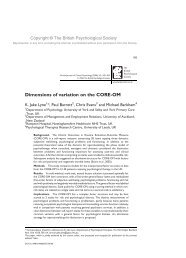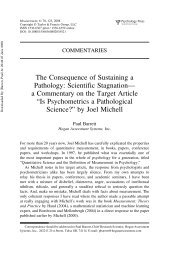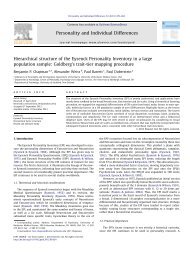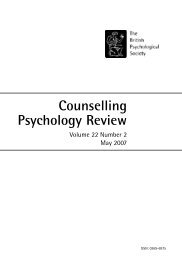Psychophysiological Methods - Paul Barrett
Psychophysiological Methods - Paul Barrett
Psychophysiological Methods - Paul Barrett
- No tags were found...
Create successful ePaper yourself
Turn your PDF publications into a flip-book with our unique Google optimized e-Paper software.
Breakwell-3389-Reference.qxd 2/7/2006 9:03 PM Page 486Burman, E. & Parker, I. (1993a). Introduction – discourse analysis: the turn to the text. InE. Burman & I. Parker (Eds), Discourse analytic research: Repertoires and readingsof texts in action. London: Routledge.Burman, E. & Parker, I. (Eds) (1993b). Discourse analytic research: Repertoires andreadings of texts in action. London: Routledge.Burr, V. (2003). Social constructionism (2nd Ed.). London: Routledge.Cabinet Office (1999). Modernising government. Cm 4310. London: Stationery Office(http://www.cabinet-office.gov.uk/moderngov/whtpaper/index.htm).Cacioppo, J. T., Tassinary, L. G. & Berntson, G. G. (2000). Handbook of psychophysiology.Cambridge: Cambridge University Press.Caldirola, D., Bellodi, L., Caumo, A., Migliarese, G. & Perna, G. (2004). Approximate entropyof respiratory patterns in panic disorder. American Journal of Psychiatry, 161, 79–87.Campbell, A. (2004). Words, words, words. British Journal of Developmental Psychology,22, 509–513.Campbell, D. T. & Stanley, J. (1966). Experimental and quasi-experimental designs forresearch. Chicago: Rand McNally.Campbell, J. M. (1992). Treating depression in well older adults: use of diaries in cognitivetherapy. Issues in Mental Health Nursing, 13(1), 19–29.Campos, J.J., Anderson, D.I., Barbu-Roth, M.A., Hubbard, E.M., Hertenstein, M.J., &Witherington, D. (2000). Travel broadens the mind. Infancy, 1, 149–219.Campos, J.J., Hiatt, S., Ramsay, D., Henderson, C. & Svejda (1978). The emergence offear of the visual cliff, In M. Lewis & L. Rosenblum (Eds) The development of fear.(pp. 149–182), New York: Plenum.Campos, J.J., Svejda, M.J., Bertenthal, B., Benson, N. & Schmid, D. (1981). Self-producedlocomotion and wariness of heights: new evidence from training studies, paper presentedat the meeting of the society for Research in Child Development, Boston, Mass.Campos, J.J., Svejda, M.J., Campos, R.G. & Bertenthal, B. (1982). The emergence ofself-produced locomotion: its importance for psychological development in infancy, InD. Bricker (Ed.) Intervention with at-risk and handicapped infants, (pp 195–216),Baltimore, Md: University Park Press.Cappello, M. (2005). Photo interviews: Eliciting data through conversations with children.Field <strong>Methods</strong>, 17, 170–182.Carlson, J. G., Seifert, A.R. & Birnbaumer, N. (1994). Clinical applied psychology. NewYork: Plenum.Carlson, N. R. (2004). Physiology of behaviour (8th edn). Boston: Pearson.Carr, W. & Kemmis, S. (1986). Becoming critical: Education, knowledge and action research.London: Falmer.Cattell, R. B. (1978). The scientific use of factor analysis. London: Plenum.Cattell, R. B. (1981). Personality and learning theory, Vols I and II. Berlin: Springer.Catterall, M. & Maclaran, P. (1997). Focus group data and qualitative analysis.Sociological Research Online, 2(1): http://www.socresonline.org.uk/2/1/6.htmlChalmers, H. & Colvin, J. (2005). Addressing environmental inequalities in UK policy: Anaction research perspective. Local Environment, 10(4), 1–28.Chamberlain, P., Camic, P. & Yardley, L. (2004). Qualitative analysis of experience:Grounded theory and case studies. In D. Marks & L.Yardley (Eds), Research <strong>Methods</strong>for Clinical and Health Psychology. London: Sage.486 RESEARCH METHODS IN PSYCHOLOGY












